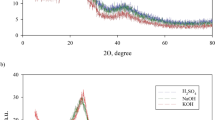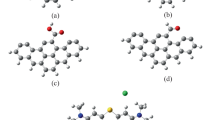Abstract
Activated carbon (AC) with high specific surface area was prepared by using bifunctional H3PO4 agent, which led to dehydrating and activation effects through hydrothermal pretreatment and subsequent pyrolysis process. N2 adsorption and desorption isotherms of AC showed a high BET surface area of 2434 m2 g−1 and a total volume of pores (VT) of 2.0447 m3 g−1 for AC. The morphology and the chemical components of hydrochar and AC were characterized by scanning electron microscopy and Fourier transform infrared spectroscopy, which indicated that H3PO4 was benefitting for the formation of porous structure of AC. Subsequently, the effect of H3PO4 in hydrothermal pretreatment and activation process was investigated by comparative experiments. The removal and adsorption of methylene blue (MB) dye with different concentrations onto the AC were studied. The monolayer equilibrium adsorption capacity was 644 mg g−1, showing that AC has good adsorption qualities for methylene blue (MB). The adsorption balance data of MB on AC was best fitted to the Redlich-Peterson model. The adsorption kinetic data fit better to the pseudo-first-order model at low MB concentration, and the pseudo-second-order and Elovich models fit better when the MB concentration was rising.









Similar content being viewed by others
References
Aksakal O, Ucun H (2010) Equilibrium, kinetic and thermodynamic studies of the biosorption of textile dye (Reactive Red 195) onto Pinus sylvestris L. J Hazard Mater 181(1–3):666–672
Basar CA (2006) Applicability of the various adsorption models of three dyes adsorption onto activated carbon prepared waste apricot. J Hazard Mater 135 1–3:232–241
Bourbrigot S, Bras ML, Delobel R, Breant P (1995) Carbonization mechanisms resulting from intumescence-part II. Association with an ethylene terpolymer and the ammonium polyphosphate-pentaerythritol fire retardant system. J M Tremillon Carbon 33:283–294
de Castro CS, Viau LN, Andrade JT, Mendonça TAP, Gonçalves M (2018) Mesoporous activated carbon from polyethyleneterephthalate (PET) waste: pollutant adsorption in aqueous solution. 42(17):14612–14619
Chen Y et al (2013) Dye removal of activated carbons prepared from NaOH-pretreated rice husks by low-temperature solution-processed carbonization and H3PO4 activation. Bioresour Technol 144.Complete:401–409
Cheng C, Liu H, Dai P, Shen X, Zhang J, Zhao T, Zhu Z (2016) Microwave-assisted preparation and characterization of mesoporous activated carbon from mushroom roots by phytic acid (C6H18O24P6) activation. J Taiwan Inst Chem Eng 67:532–537
Foo KY, Hameed BH (2012) Preparation, characterization and evaluation of adsorptive properties of orange peel based activated carbon via microwave induced K2CO3 activation. Bioresour Technol 104 none:679–686
Fraga TJM et al (2018) Treated residue from aluminium lamination as adsorbent of toxic reactive dyes – a kinetic, equilibrium and thermodynamic study. Environ Technol 21:1–13
Francis F et al (2003) Use of response surface methodology for optimizing process parameters for the production of ??-amylase by Aspergillus oryzae. Biochem Eng J 2:107–115
Ghani ZA, Yusoff MS, Zaman NQ, Zamri MFMA, Andas J (2017) Optimization of preparation conditions for activated carbon from banana pseudo-stem using response surface methodology on removal of color and COD from landfill leachate. Waste Manag 62:177–187. https://doi.org/10.1016/j.wasman.2017.02.026
Gupta SS, Bhattacharyya KG (2011) Kinetics of adsorption of metal ions on inorganic materials: A review. Adv Colloid Interface Sci 162 1–2:39–58
Harun R, Danquah MK (2011) Influence of acid pre-treatment on microalgal biomass for bioethanol production. Process Biochem 46(1):304–309
Islam MA et al (2017) Mesoporous activated coconut shell-derived hydrochar prepared via hydrothermal carbonization-NaOH activation for methylene blue adsorption. J Environ Manag 203:237–244
Jiao D, Liang Y, Dehui D, Xiaoqi C, Fan Y, B " X (2013) Highly active reduction of oxygen on a FeCo alloy catalyst encapsulated in pod-like carbon nanotubes with fewer walls. J Mater Chem A1(47):14868–14873
Jindarom C, Meeyoo V, Kitiyanan B, Rirksomboon T, Rangsunvigit P (2007) Surface characterization and dye adsorptive capacities of char obtained from pyrolysis/gasification of sewage sludge. Chem Eng J 133:239–246
Kacan E (2016) Optimum BET surface areas for activated carbon produced from textile sewage sludges and its application as dye removal. J Environ Manag 166:116–123
Kaouah F, Boumaza S, Berrama T, Trari M, Bendjama Z (2013) Preparation and characterization of activated carbon from wild olive cores (oleaster) by H 3 PO 4, for the removal of basic red 46[J]. J Clean Prod 54(8):296–306
Khan TA, Chaudhry SA, Ali I (2015) Equilibrium uptake, isotherm and kinetic studies of cd (II) adsorption onto iron oxide activated red mud from aqueous solution. J Mol Liq 202:165–175
Kumar KV, Ramamurthi V, Sivanesan S (2005) Modeling the mechanism involved during the sorption of methylene blue onto fly ash. J Colloid Interface Sci 284(1):14–21
Lim WC, Srinivasakannan C, Balasubramanian N (2010) Activation of palm shells by H3PO4impregnation for high yielding activated carbon [J]. J Anal Appl Pyrolysis 88(2):181–186
Lima EC, Hosseini-Bandegharaei A, Moreno-Piraján JC, Anastopoulos I (2019) A critical review of the estimation of the thermodynamic parameters on adsorption equilibria. Wrong use of equilibrium constant in the Van't hoof equation for calculation of thermodynamic parameters of adsorption. J Mol Liq 273:425–434
Liu QS, Zheng T, Wang P, Guo L (2010) Preparation and characterization of activated carbon from bamboo by microwave-induced H3PO4 activation. Ind Crop Prod 31(2):233–238. https://doi.org/10.1016/j.indcrop.2009.10.011
Pezoti O, Cazetta AL, Bedin KC, Souza LS, Martins AC, Silva TL, Santos Júnior OO, Visentainer JV, Almeida VC (2016) Naoh-activated carbon of high surface area produced from guava seeds as a high-efficiency adsorbent for amoxicillin removal: kinetic, isotherm and thermodynamic studies. Chem Eng J 288:778–788
Rangabhashiyam S, Selvaraju N (2015) Evaluation of the biosorption potential of a novel Caryota urens inflorescence waste biomass for the removal of hexavalent chromium from aqueous solutions. J Taiwan Inst Chem Eng 47:59–70
Romero-Anaya AJ et al (2012) Hydrothermal and conventional H3PO4 activation of two natural bio-fibers. Carbon 50(9):3158–3169
Savova D, Apak E, Ekinci E, Yardim F, Petrov N, Budinova T, Razvigorova M, Minkova V (2001) Biomass conversion to carbon adsorbents and gas. Biomass Bioenergy 21(2):133–142. https://doi.org/10.1016/S0961-9534(01)00027-7
Sepehr MN, Amrane A, Karimaian KA, Zarrabi M, Ghaffari HR (2014) Potential of waste pumice and surface modified pumice for hexavalent chromium removal: characterization, equilibrium, thermodynamic and kinetic study. J Taiwan Inst Chem Eng 45(2):635–647
Sevilla M, Fuertes AB, Mokaya R (2011) High density hydrogen storage in superactivated carbons from hydrothermally carbonized renewable organic materials. Energy Environ Sci 4(4):1400–1410
Silva TL et al (2016) Mesoporous activated carbon from industrial laundry sewage sludge: adsorption studies of reactive dye Remazol Brilliant Blue R. Chem Eng J 303:467–476 S1385894716308166
Solum MS, Pugmire RJ, Jagtoycn M (1995a) Evolution of carbon structure in chemically activated wood. F Derbyshire Carbon 33:1247–1254
Solum MS, Pugmire RJ, Jagtoyen M, Derbyshire F (1995b) Evolution of carbon structure in chemically activated wood [J]. Carbon 33(9):1247–1254
Teng H, Yeh TS, Hsu LY (1998) Preparation of activated carbon from bituminous coal with phosphoric acid activation. Carbon 36:1387–1395
Tzong-Horng L (2010) Development of mesoporous structure and high adsorption capacity of biomass-based activated carbon by phosphoric acid and zinc chloride activation. Chem Eng J 158:129–142
Vargas AMM et al (2012) Kinetic and equilibrium studies: Adsorption of food dyes Acid Yellow 6, Acid Yellow 23, and Acid Red 18 on activated carbon from flamboyant pods. Chem Eng J 181–182 none:243–250
Walker GM, Weatherley LR (2000) Prediction of Bisolute dye adsorption isotherms on activated carbon. Process Saf Environ Prot 78(3):219–223. https://doi.org/10.1205/095758200530673
Yue QY et al (2007) Formation and characteristics of cationic-polymer/bentonite complexes as adsorbents for dyes. Appl Clay Sci 35(3–4):0–275
Zhu G et al (2017) Effect of acid and hydrothermal treatments on the dye adsorption properties of biomass-derived activated carbon. J Mater Sci 52(13):7664–7676
Funding
The National Natural Science Foundation of China provided Youth fund (Grant no. 21601044), and Huangshan Youth Scholar Fund (Grant no. 407-037175) provided financial support.
Author information
Authors and Affiliations
Corresponding author
Additional information
Responsible editor: Tito Roberto Cadaval Jr
Publisher’s note
Springer Nature remains neutral with regard to jurisdictional claims in published maps and institutional affiliations.
Rights and permissions
About this article
Cite this article
Ma, P., Wang, S., Wang, T. et al. Effect of bifunctional acid on the porosity improvement of biomass-derived activated carbon for methylene blue adsorption. Environ Sci Pollut Res 26, 30119–30129 (2019). https://doi.org/10.1007/s11356-019-06177-9
Received:
Accepted:
Published:
Issue Date:
DOI: https://doi.org/10.1007/s11356-019-06177-9




